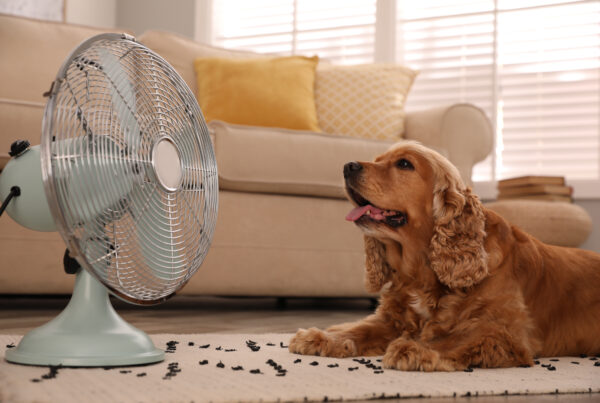
Many pet owners don’t realize their stress can seriously affect their furry friends. Studies have shown that cats and dogs often pick up on their owner’s anxiety, impacting them deeply.
This blog will guide you through understanding how your stress levels could influence your pets’ well-being and offer strategies for creating a calmer environment for everyone. Keep reading to learn how to keep both you and your pets happier.
Ways Stress Can Affect Cats and Dogs
Experiencing stress can lead to physical symptoms and changes in behavior for cats and dogs. It may also have a significant impact on their overall health and emotional well-being.
Physical symptoms
Cats and dogs often show stress through physical symptoms that pet owners can spot. These signs include excessive grooming in cats, leading to bald patches, while dogs might start shedding more than usual.
Both animals could experience changes in eating habits, such as loss of appetite or overeating. Stomach upsets or diarrhea are also common indicators of stress.
Other noticeable symptoms involve a change in sleep patterns where your furry friend may sleep too much or too little. Cats especially may hide more frequently, seeking solitude when they’re feeling stressed.
Dogs, on the other hand, might pant excessively or shake even when it’s not hot. Recognizing these physical signs early plays a crucial role in managing cat stress and ensuring the wellbeing of pets under your care.
Changes in behavior
Cats and dogs may exhibit changes in behavior when experiencing stress. These changes can include decreased appetite, excessive grooming, hiding, aggression, or clinginess. Pet owners should also watch for unusual vocalizations, such as increased meowing or barking.
Additionally, stressed pets might become more withdrawn or display destructive behaviors like chewing furniture or digging. Observing these behavioral changes is crucial in identifying and addressing the sources of stress in cats and dogs.
It’s important to recognize that pets respond differently to stress, so it’s vital to be attentive to any behavioral variations from their normal patterns. By understanding these signals, pet owners can take proactive steps to mitigate stress and support the emotional wellbeing of their furry companions.
Impact on overall health
As stress continues, it can take a toll on the overall health of cats and dogs. Stress in pets might lead to various health issues such as digestive problems, skin conditions, weakened immune systems, and even an increased risk of certain diseases.
It is essential for pet owners to be aware of the impact that stress can have on their furry friends’ physical well-being and take proactive steps to manage and reduce their stress levels to maintain optimal health.
Pet owners must understand that prolonged stress can negatively affect their pets’ mental and emotional well-being, contributing to anxiety disorders and other psychological issues.
How to Reduce Stress in Cats and Dogs
Identify sources of stress by observing your pet’s behavior and environment. Create a calm and comfortable living space for your cats and dogs to help reduce their stress levels.
Identifying sources of stress
Recognizing the sources of stress in your pets is essential for their well-being. Look for changes in routine, such as new family members, moving to a new home, or alterations in their environment.
Keep an eye out for loud noises, lack of stimulation, and feelings of confinement that can trigger stress responses in cats and dogs. Additionally, transitions like weaning or separation anxiety may also contribute to heightened stress levels in your furry companions.
Understanding the triggers that cause stress in pets allows you to take proactive measures to mitigate its impact on their mental and physical health.
Creating a calm and comfortable environment
After identifying sources of stress, it’s crucial to create a calm and comfortable environment for your pets. Provide a safe space where they can retreat if they feel overwhelmed. Use calming pheromones or soothing music to help reduce their anxiety.
Ensure access to fresh water, comfortable bedding, and toys for mental stimulation. Additionally, establish predictable routines to give them a sense of security and stability.
To further enhance the environment, consider the placement of food and water bowls in quiet areas away from high-traffic zones. Create designated play areas with scratching posts for cats and interactive toys for dogs.
Providing mental and physical stimulation
Engage your pets’ minds and bodies by providing mental and physical stimulation. Interactive toys, puzzle feeders, and regular play sessions help keep them active and mentally sharp.
Offer a variety of toys to prevent boredom – consider catnip-filled mice for cats, or chew toys and treat-dispensing puzzles for dogs. Regular exercise is crucial; daily walks or indoor playtime can reduce stress and anxiety while promoting overall well-being.
Rotate their toys regularly to maintain interest, and consider introducing new activities like agility training or simple obedience exercises. Mental enrichment also includes interactive games where they must use problem-solving skills.
Seeking professional help if needed
If you notice persistent signs of stress in your cat or dog, such as changes in behavior or physical symptoms, it’s crucial to seek professional help promptly. Professional veterinarians and animal behaviorists can offer valuable insights and effective strategies to address your pet’s stress and improve their mental wellbeing.
They can provide tailored advice on managing your pet’s anxiety, recommend suitable coping strategies, and suggest appropriate therapies or medications if necessary.
If you’re unsure about the best course of action for supporting your pet’s mental health, consulting with a professional will help you gain clarity and ensure that you’re taking the right steps to alleviate their stress.
Conclusion
Understanding how human stress impacts our pets is essential for responsible pet ownership. By recognizing the signs of stress in cats and dogs, we can take proactive steps to minimize its effects on their well-being.
Creating a nurturing environment and providing mental and physical stimulation are crucial in helping our furry friends cope with stress. Seeking professional help when needed ensures that our pets receive the care they deserve to lead happy and healthy lives.
FAQs
1. Can my stress affect my cat or dog?
Yes, your stress can impact your pets. Cats and dogs can sense human emotions and may show signs of anxiety or behavioral problems when they feel the stress from their owners.
2. What are some signs that my pet is stressed because of me?
Signs of stress in cats include hiding more often, changes in eating habits, or showing aggression. Dogs might bark more, become destructive, or have accidents inside the house.
3. How does human stress lead to health issues in pets?
When pets pick up on their owner’s stress, it can lead to anxiety that affects their mental wellbeing and physical health. This could result in feline stress symptoms like over-grooming or digestive issues for both cats and dogs.
4. What can I do to reduce my pet's stress related to my own emotions?
Practicing good stress management for yourself is a start. Also, establish a calm environment at home and use cat or dog-specific techniques such as play therapy or calming products designed for pet anxiety relief.
5. Why is understanding pet emotions important for animal welfare?
Understanding how our emotions affect our pets helps us better care for them by recognizing when they’re stressed and taking steps to improve their mental wellbeing along with our own, which is crucial for overall animal welfare.



